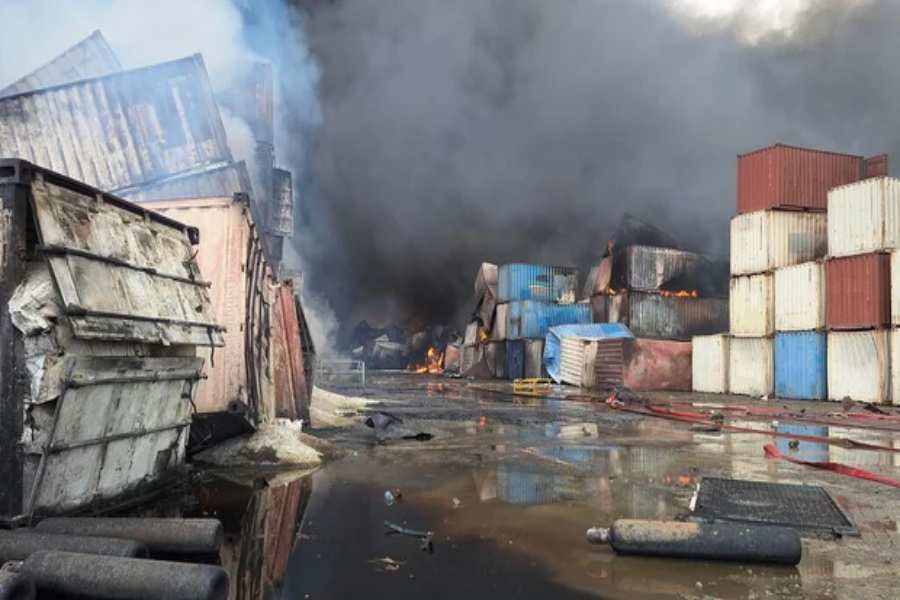A catastrophic explosion and fire tore through the Shahid Rajaei port in southern Iran on Saturday, killing at least 14 people and injuring more than 750, Iranian officials confirmed. The blast, which occurred at one of Iran’s busiest shipping hubs near Bandar Abbas on the Strait of Hormuz, is believed to have involved hazardous chemical materials linked to Iran’s missile program.
The explosion came at a highly sensitive time for Tehran, coinciding with the third round of nuclear negotiations between Iran and the United States, held Saturday in Oman. While Iranian authorities have not publicly suggested the blast was an act of sabotage, security services were already on high alert amid fears of foreign interference. Iran’s Interior Minister Eskandar Momeni announced the updated casualty figures via Telegram early Sunday, while Iranian President Masoud Pezeshkian expressed condolences and promised a thorough investigation.
Official explanations remained vague in the immediate aftermath. State-run IRNA cited the Iranian Customs Administration, attributing the blast to a “stockpile of hazardous goods and chemical materials” stored in the port area. However, independent reports suggest a more dangerous context. According to Ambrey, a private maritime security firm, the fire was “the result of improper handling of a shipment of solid fuel intended for use in Iranian ballistic missiles.” Specifically, the port had received a delivery of sodium perchlorate — a chemical commonly used as rocket propellant — earlier this year. The shipment reportedly originated from China, arriving aboard two vessels first tracked by the Financial Times. Ship-tracking data reviewed by the Associated Press confirms that one of the vessels transporting the chemical was near the Shahid Rajaei port in March. However, Iranian officials have not publicly acknowledged the arrival or storage of the material, raising questions about port safety protocols.
The visible reddish smoke captured in several social media videos just before the explosion further indicates the presence of chemical compounds in the fire, consistent with sodium perchlorate combustion characteristics. Amateur videos circulated online showed growing flames and thick black smoke in the minutes leading up to the explosion. In one alarming clip, a man can be heard warning, “Get back! Tell the gas truck to go! It’s going to blow up!” Moments later, the blast obliterates the scene, sending debris and shockwaves miles away. Witnesses reported windows shattered in buildings kilometers from the blast center. Iranian state media footage showed chaotic scenes in local hospitals, where dozens of ambulances ferried injured individuals, overwhelming medical facilities. Officials from Iran’s provincial disaster management agency confirmed that several port containers had detonated. State television later reported a building collapse linked to the explosion but provided no additional details.
The Shahid Rajaei port has a history of being a strategic and vulnerable asset. In 2020, it was the target of a cyberattack widely attributed to Israeli intelligence agencies. That attack, which temporarily paralyzed port operations, came amid escalating cyber-conflict between Iran and Israel over critical infrastructure vulnerabilities. Saturday’s explosion is particularly alarming given Iran’s history with mishandled hazardous materials. The 2020 Beirut port blast, caused by improperly stored ammonium nitrate, remains a stark regional reminder of the devastating potential of explosive cargoes. Despite that tragedy, authorities appear to have allowed dangerous chemicals to remain in Shahid Rajaei’s port area for months.
The timing of the explosion — coinciding with U.S.–Iran nuclear talks — and its link to missile fuel compounds suggest broader implications. Iran’s missile stockpiles, depleted by direct attacks on Israel during recent conflicts in Gaza, are being replenished with shipments like the sodium perchlorate recently imported. Although no official has directly accused any outside actor of causing the explosion, the context of heightened tensions and previous sabotage attempts cannot be ignored. Iranian Foreign Minister Abbas Araghchi had warned just days earlier of “past instances of attempted sabotage and assassination operations” targeting the country.
The Iranian Interior Ministry has launched a full investigation into the blast’s causes. Early efforts are focused on determining liability regarding the chemical storage and handling protocols at the port. Meanwhile, the tragedy underscores Iran’s broader security challenges — not only concerning its ballistic missile program but also its critical infrastructure vulnerabilities. As Tehran presses forward with nuclear negotiations and amid ongoing regional conflicts, Saturday’s deadly explosion may have lasting repercussions on both domestic public opinion and international diplomacy.
